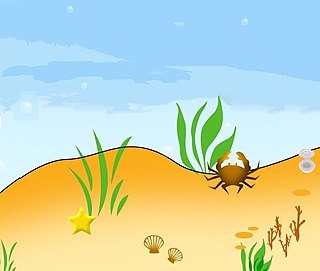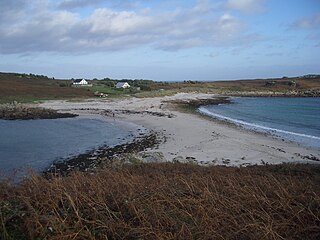
Benthos, also known as benthon, is the community of organisms that live on, in, or near the bottom of a sea, river, lake, or stream, also known as the benthic zone. This community lives in or near marine or freshwater sedimentary environments, from tidal pools along the foreshore, out to the continental shelf, and then down to the abyssal depths.

In oceanography, geomorphology, and geoscience, a shoal is a natural submerged ridge, bank, or bar that consists of, or is covered by, sand or other unconsolidated material and rises from the bed of a body of water to near the surface. It often refers to those submerged ridges, banks, or bars that rise near enough to the surface of a body of water as to constitute a danger to navigation. Shoals are also known as sandbanks, sandbars, or gravelbars. Two or more shoals that are either separated by shared troughs or interconnected by past or present sedimentary and hydrographic processes are referred to as a shoal complex.

The seabed is the bottom of the ocean. All floors of the ocean are known as 'seabeds'.

Kaikō was a remotely operated underwater vehicle (ROV) built by the Japan Agency for Marine-Earth Science and Technology (JAMSTEC) for exploration of the deep sea. Kaikō was the second of only five vessels ever to reach the bottom of the Challenger Deep, as of 2019. Between 1995 and 2003, this 10.6 ton unmanned submersible conducted more than 250 dives, collecting 350 biological species, some of which could prove to be useful in medical and industrial applications. On 29 May 2003, Kaikō was lost at sea off the coast of Shikoku Island during Typhoon Chan-Hom, when a secondary cable connecting it to its launcher at the ocean surface broke.

Pelagic sediment or pelagite is a fine-grained sediment that accumulates as the result of the settling of particles to the floor of the open ocean, far from land. These particles consist primarily of either the microscopic, calcareous or siliceous shells of phytoplankton or zooplankton; clay-size siliciclastic sediment; or some mixture of these. Trace amounts of meteoric dust and variable amounts of volcanic ash also occur within pelagic sediments. Based upon the composition of the ooze, there are three main types of pelagic sediments: siliceous oozes, calcareous oozes, and red clays.

Marine sediment, or ocean sediment, or seafloor sediment, are deposits of insoluble particles that have accumulated on the seafloor. These particles have their origins in soil and rocks and have been transported from the land to the sea, mainly by rivers but also by dust carried by wind and by the flow of glaciers into the sea. Additional deposits come from marine organisms and chemical precipitation in seawater, as well as from underwater volcanoes and meteorite debris.

A contourite is a sedimentary deposit commonly formed on continental rise to lower slope settings, although they may occur anywhere that is below storm wave base. Countourites are produced by thermohaline-induced deepwater bottom currents and may be influenced by wind or tidal forces. The geomorphology of contourite deposits is mainly influenced by the deepwater bottom-current velocity, sediment supply, and seafloor topography.
ABISMO is a remotely operated underwater vehicle (ROV) built by the Japan Agency for Marine-Earth Science and Technology (JAMSTEC) for exploration of the deep sea. It is the only remaining ROV rated to 11,000-meters, ABISMO is intended to be the permanent replacement for Kaikō, a ROV that was lost at sea in 2003.
Altererythrobacter is a bacterial genus from the family Erythrobacteraceae.
Tsuneonella troitsensis is a Gram-negative, aerobic, halotolerant, rod-shaped and motile bacterium from the genus Tsuneonella which has been isolated from the sea urchin Strongylocentrotus intermedius.
Arenibacter is a rod-shaped and strictly aerobic genus from the family of Flavobacteriaceae.
Arenibacter certesii is a heterotrophic and aerobic bacterium from the genus of Arenibacter which has been isolated from the green alga Ulva fenestrata from the Sea of Japan.
Arenibacter echinorum is a heterotrophic and aerobic bacterium from the genus Arenibacter which has been isolated from the sea urchin Strongylocentrotus intermedius from the Sea of Japan.
Arenibacter hampyeongensis is a Gram-negative, strictly aerobic bacterium from the genus Arenibacter which has been isolated from tidal flat from Hampyeong in Korea.
Arenibacter nanhaiticus is a Gram-negative, rod-shaped and aerobic bacterium from the genus Arenibacter which has been isolated from sandy sediments from the South China Sea.
Arenibacter palladensis is a heterotrophic and aerobic bacterium from the genus Arenibacter which has been isolated from the green alga Ulva fenestrata in the Sea of Japan.
Arenibacter latericius is a Gram-negative, aerobic, rod-shaped and non-motile bacterium from the genus Arenibacter which has been isolated from sandy sediments from the South China Sea.
Arenibacter antarcticus is a Gram-negative, strictly aerobic and rod-shaped bacterium from the genus of Arenibacter which has been isolated from sediments the Ross Sea.
Arenibacter catalasegens is a Gram-negative, aerobic, rod-shaped and non-motile bacterium from the genus of Arenibacter which has been isolated from surface sediments from the Southern Indian Ocean.
Oceanisphaera litoralis is a Gram-negative, aerobic and moderately halophilic bacterium from the genus of Oceanisphaera which has been isolated from sediments from the Sea of Japan in Russia.





